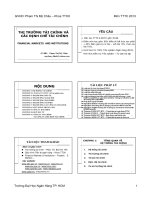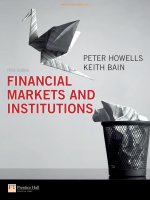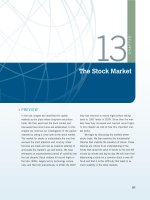SLide financial markets and institutions
Bạn đang xem bản rút gọn của tài liệu. Xem và tải ngay bản đầy đủ của tài liệu tại đây (3.81 MB, 47 trang )
OUTLINE
1. Why study financial markets and institutions?
2. Overview of financial markets
3. Overview of financial institutions
Chapter 1:
Introduction
2. Overview of Financial Markets
1. Why Study Financial Markets and Institutions?
A financial market is a market in which financial assets (securities) can
be purchased or sold
Financial markets and institutions are primary channels to
allocate capital in our society.
Financial markets facilitate financing and investing by households,
firms, and government agencies
Proper capital allocation leads to growth in:
Societal wealth.
Income.
Financial markets are one type of structure through which funds
flow: Channels funds from person or business without investment
opportunities (i.e., “Lender-Savers”) to one who has them (i.e.,
“Borrower-Spenders”)
Economic opportunity.
Well functioning financial markets are key factors in producing
high economic growth
Improves economic efficiency
Financial institutions are needed because of transactions costs,
risk sharing, and asymmetric information
•1-4
Financial Markets Funds Transferees
Lender-Savers
Borrower-Spenders
1.
Households
1.
Business firms
2.
Business firms
2.
Government
3.
Government
3.
Households
4.
Foreigners
4.
Foreigners
Function of Financial Markets
Segments of Financial Markets
1.
Direct Finance
Borrowers borrow directly from lenders in financial markets by
selling financial instruments which are claims on the
borrower’s future income or assets
2.
Indirect Finance
Borrowers borrow indirectly from lenders via financial
intermediaries (established to source both loanable funds and
loan opportunities) by issuing financial instruments which are
claims on the borrower’s future income or assets
Classification
Financial markets can be distinguished along a variety of
dimensions:
primary versus secondary markets.
money versus capital markets.
debt versus equity markets.
Primary markets.
Markets in which users of funds (e.g., corporations) raise funds by
issuing new financial instruments (e.g., stocks and bonds).
Secondary markets.
Markets where existing financial instruments are traded among
investors (e.g., exchange traded: NYSE and over-the-counter:
NASDAQ).
•1-9
Primary versus Secondary Markets
Primary versus Secondary Markets
Primary and Secondary Market Transfer of Funds Time Line
Primary versus Secondary Markets Concluded
How were primary markets affected by the financial crisis?
We can further classify secondary markets as follows:
Do secondary markets add value to society or are they simply a
legalized form of gambling?
1. Exchanges
How does the existence of secondary markets affect primary
markets?
Trades conducted in central locations (e.g., New York Stock
Exchange)
2. Over-the-Counter Markets
Dealers at different locations buy and sell
Best example is the market for Treasury Securities
Money Market Instruments Outstanding.
Money markets.
Markets that trade debt securities with maturities of one year or
less (e.g., C D s and U.S. Treasury bills).
little or no risk of capital loss, but low return.
Capital markets.
Markets that trade debt (bonds) and equity (stock) instruments
with maturities of more than one year.
substantial risk of capital loss, but higher promised return.
Money Market Instruments Outstanding, ($Tn)
Money versus Capital Markets
Source: Federal Board, “Financial Accounts of the United States,” Statistical Releases, Washington, D C, various issues,
www.federalreserve.gov.
•114
Capital Market Instruments Outstanding.
Capital Market Instruments
Outstanding, ($Tn)
Debt markets versus Equity markets
1.
Debt Markets
Short-Term (maturity < 1 year)
Long-Term (maturity > 10 year)
Intermediate term (maturity in-between)
2.
Equity Markets
Pay dividends, in theory forever
Represents an ownership claim in the firm
Source: Federal Reserve Board, “Financial Accounts of the United States,” Statistical Releases, Washington, DC,
various issues. www.federalreserve.gov.
Foreign Exchange (FX) Markets
FX markets.
Trading one currency for another (e.g., dollar for yen).
Spot FX.
the immediate exchange of currencies at current exchange rates.
Forward FX.
the exchange of currencies in the future on a specific date and at a
pre-specified exchange rate.
Derivatives and the Crisis
Subprime mortgage losses were large, reaching over $700 billion.
The “Great Recession” was the worst since the “Great Depression”
of the 1930s.
Trillions $ global wealth lost, peak to trough stock prices fell over 50%
in the U.S.
Lingering high unemployment and below trend growth in the U.S.
Sovereign debt levels in developed economies reached post-war alltime highs.
Derivative Security Markets
Derivative security.
A financial security whose payoff is linked to (i.e., “derived” from)
another, previously issued security such as a security traded in
capital or foreign exchange markets.
Generally an agreement to exchange a standard quantity of assets at a
set price on a specific date in the future.
The main purpose of the derivatives markets is to transfer risk
between market participants.
Valuation of Securities in Financial Markets
Securities are valued as the present value of their expected
cash flows, discounted at a rate that reflects their
uncertainty
Market pricing of securities
Different investors may value the same security differently based
on their interpretation of information
Impact of valuations on pricing
Every security has an equilibrium market price at which demand
and supply for the security are equal
Favorable information results in upward valuation revisions;
unfavorable information results in downward revisions
Securities reach a new equilibrium price as new information
becomes available
•1-19
20
Non-Intermediated (Direct) Flows of
Funds
3. Overview of Financial Institutions
Markets are imperfect
Flow of Funds in a World without FIs
Financial institutions are needed to resolve problems
created by market imperfections
Direct Financing
Financial Claims (equity and debt instruments)
Financial Institutions.
Institutions through which suppliers channel money to users of funds.
Access the long description slide.
•1-22
Percentage Shares of Assets of Financial
Institutions in the United States, 1948–2016
Figure 1-7 Flow of Funds in a World with Fls
Intermediated Flows of Funds
Flow of Funds in a World with FIs.
Access the long description slide.
We describe and illustrate this flow of funds in Chapter 2.
Access the long description slide.
•123
•1-24
Indirect finance
Financial intermediation is actually the primary means of
moving funds from lenders to borrowers.
More important source of finance than securities markets (such
as stocks)
Needed because of transactions costs, risk sharing, and
asymmetric information
Source: Andreas Hackethal and Reinhard H. Schmidt, “Financing Patterns: Measurement Concepts
and Empirical Results,” Johann Wolfgang Goethe-Universitat Working Paper No. 125, January
2004. The data are from 1970–2000 and are gross flows as percentage of the total, not including
trade and other credit data, which are not available.
•26
Function of Financial
Institutions: Indirect Finance
Function of Financial
Institutions: Indirect Finance
Transactions Costs
Risk sharing
1.
Financial intermediaries make profits by reducing
transactions costs
2.
Reduce transactions costs by developing expertise and taking
advantage of economies of scale
FIs create and sell assets with lesser risk to one
party in order to buy assets with greater risk from another party
This process is referred to as asset transformation, because in a
sense risky assets are turned into safer assets for investors
Function of Financial
Intermediaries: Indirect Finance
Asymmetric information: Adverse selection
and Moral hazard
Another reason FIs exist is to reduce the impact of asymmetric
information.
One party lacks crucial information about another party,
impacting decision-making.
We usually discuss this problem along two fronts: adverse
selection and moral hazard.
Adverse
selection
Asymmetric information: Adverse selection
Before the
After the
transaction occur Asymmetric transaction occur
information
Moral
hazard
Function of Financial Intermediaries
Adverse Selection
Adverse
selection
Before the
After the
transaction occur Asymmetric transaction occur
information
Potential borrowers who are the
most likely to produce an
undesirable (adverse) outcome – the
bad credit risks – are the most likely
to be selected
Moral
hazard
1.
Before transaction occurs
2.
Potential borrowers most likely to produce adverse outcome
are ones most likely to seek a loan
3.
Similar problems occur with insurance where unhealthy
people want their known medical problems covered
Function of Financial Intermediaries
Asymmetric information: Moral hazard
Moral Hazard
Adverse
selection
Before the
After the
transaction occur Asymmetric transaction occur
information
Moral
hazard
1.
After transaction occurs
2.
Hazard that borrower has incentives to engage in undesirable (immoral)
activities making it more likely that won’t pay loan back
3.
Again, with insurance, people may engage in risky activities only after
being insured
4.
Another view is a conflict of interest
The risk (hazard) that the borrower
might engage in activities that are
undesirable (immoral) from the
lender’s point of view
Asymmetric Information: Adverse Selection and
Moral Hazard
Financial intermediaries reduce adverse selection and moral
hazard problems, enabling them to make profits. How they
accomplish this is covered in many of the chapters to come.
Economies of Scope and
Conflicts of Interest
FIs are able to lower the production cost of information by using the
information for multiple services: bank accounts, loans, auto
insurance, retirement savings, etc. This is called economies of
scope.
But, providing multiple services may lead to conflicts of interest,
perhaps causing one area of the FI to hide or conceal
information from another area (or the economy as a whole).
This may actually make financial markets less efficient!
Types of Financial Institutions
Financial Institutions are distinguished by:
Whether they accept insured deposits.
Depository versus non-depository financial institutions.
Whether they receive contractual payments from customers.
Types of Financial Intermediaries
Primary Assets
and Liabilities of
Financial
Intermediaries
• Depository institutions
• Contractual savings institutions
• Investment intermediaries
Types of Financial Intermediaries
Principal
Financial
Intermediaries
and Value of
Their Assets
Depository versus Non-Depository FIs
FIs Benefit Suppliers of Funds
Depository institutions:
Reduce monitoring costs.
commercial banks, savings associations, savings banks, credit
unions.
Increase liquidity and lower price risk.
Reduce transaction costs.
Non-depository institutions.
Contractual:
insurance companies, pension funds,
Provide maturity intermediation.
Provide denomination intermediation.
Non-contractual:
securities firms and investment banks, mutual funds.
FIs Benefit the Overall Economy
Conduit through which Federal Reserve conducts monetary
policy.
Risks Faced by Financial Institutions
Credit.
Off-balance-sheet.
Foreign exchange.
Liquidity.
Provides efficient credit allocation.
Country or sovereign.
Technology.
Provide for intergenerational wealth transfers.
Interest rate.
Operational.
Market.
Insolvency.
Provide payment services.
Volcker Rule: Insured institutions may not engage in proprietary trading
Regulation of Financial Institutions
Globalization of Financial Markets and Institutions
FIs are heavily regulated to protect society at large from market
failures.
The pool of savings from foreign investors is increasing and
investors look to diversify globally now more than ever before.
Regulations impose a burden on FIs; before the financial crisis,
U.S. regulatory changes were deregulatory in nature.
Information on foreign markets and investments is becoming
readily accessible and deregulation across the globe is allowing
even greater access to foreign markets.
Regulators attempt to maximize social welfare while minimizing
the burden imposed by regulation.
International mutual funds allow diversified foreign investment
with low transactions costs.
Global capital flows are larger than ever.
OUTLINE
1. Interest Rate Fundamentals
2. Loanable Funds Theory
3. Economic Forces That Affect Interest Rates
Chapter 2:
Determinants of Interest rates
Real Riskless Interest Rates
1. Interest Rate Fundamentals
Nominal interest rates: the interest rates actually observed in
financial markets.
Additional purchasing power required to forego current consumption.
What causes differences in nominal and real interest rates?
If you wish to earn a 3% real return and prices are expected to increase by
2%, what rate must you charge?
Irving Fisher first postulated that interest rates contain a premium for
expected inflation.
Used to determine fair present value and prices of securities.
Two components:
Opportunity cost.
Adjustments for individual security characteristics.
•2-3
•2-4
Loanable funds theory explains interest rates and interest rate
movements
Views level of interest rates as resulting from factors that affect the
supply of and demand for loanable funds
Categorizes financial market participants – e.g., consumers, businesses,
governments, and foreign participants – as net suppliers or demanders
of funds
•2-5
TABLE 2–1 Funds Supplied and Demanded by Various Groups (in trillions of dollars)
Funds Supplied
Funds
Demanded
Households
$70.33
$14.51
$55.82
Business—nonfinancial
23.20
55.85
−32.65
Business—financial
85.91
96.90
−10.99
Government units
5.22
23.19
−17.97
Foreign participants
23.03
17.24
5.79
•2-6
Determinants of Household Savings
Net Supply & Demand of Funds in U.S. in 2016
Net Funds Supplied
(Funds Supplied—
Funds Demanded)
Supply and Demand for Loanable Funds
2. Loanable Funds Theory
Interest rates and tax policy.
Income and wealth: the greater the wealth or income, the greater the
amount saved.
Attitudes about saving versus borrowing.
Credit availability: the greater the amount of easily obtainable
consumer credit the lower the need to save.
Job security and belief in soundness of entitlements.
Source: Federal Reserve Board website, “Financial Accounts of the United States,” May 2016. www.federalreserve.gov
•2-7
•2-8
Business Demand for Funds
Federal Government Demand for Funds Concluded
Governments borrow heavily in the markets for loanable funds.
Level of interest rates:
$23.19 trillion in 2016.
When the cost of loanable funds is high (i.e., interest rates are high),
businesses finance internally.
United States.
Expected future profitability vs. risk:
National debt was $19.21 trillion in 2016.
The greater the number of profitable projects available to businesses, the
greater the demand for loanable funds.
National debt (and interest payments on the national debt) have to be financed in
large part by additional borrowing.
Expected economic growth.
•2-9
•2-10
Figure The Effect on Interest Rates from a Shift in the Supply Curve
of or Demand Curve for Loanable Funds
Determinants of Foreign Funds Invested in the U.S.
Relative interest rates and returns on global investments.
Expected exchange rate changes.
Safe haven status of U.S. investments.
Foreign central bank investments in the U.S.
•2-11
Effect on Interest Rates from a Shift in
the Supply Curve for Loanable Funds
(a) Increase in the supply of loanable funds
(b) Increase in the demand for loanable funds
Effect on Interest Rates from a Shift in
the Demand Curve for Loanable Funds
Loanable Funds Theory (cont’d)
Supply of loanable funds
Funds are provided to financial markets by
Households (net suppliers of funds)
Government units and businesses (net borrowers of funds)
Suppliers of loanable funds supply more funds at higher interest
rates
•14
Loanable Funds Theory (cont’d)
Loanable Funds Theory (cont’d)
Supply of loanable funds (cont’d)
Foreign households, governments, and corporations supply funds by
purchasing Treasury securities
SA
Foreign households have a high savings rate
The supply is influenced by monetary policy implemented by the
Federal Reserve System
The Fed controls the amount of reserves held by depository institutions
The supply curve can shift in response to economic conditions
Households would save more funds during a strong economy
Aggregate Supply
•15
•16
Loanable Funds Theory (cont’d)
Equilibrium interest rate - algebraic
SA
The aggregate demand can be written as
DA Dh Db Dg Dm Df
i
The aggregate supply can be written as
DA
S A Sh Sb Sg Sm Sf
Equilibrium Interest Rate - Graphic
•18
3. Economic Forces That Affect Interest Rates
Economic growth
Economic growth
Shifts the demand schedule outward (to the right)
There is no obvious impact on the supply schedule
SA
Supply could increase if income increases as a result of the expansion
i2
i
The combined effect is an increase in the equilibrium interest rate
DA2
DA
Impact of Economic Expansion
•19
•20
Economic Forces That Affect Interest Rates
(cont’d)
Inflation
Inflation
SA2SA
Shifts the supply schedule inward (to the left)
Households increase consumption now if inflation is expected to
increase
i2
Shifts the demand schedule outward (to the right)
i
Households and businesses borrow more to purchase products before
prices rise
DA2
DA
Impact of Expected Increase in Inflation
•21
Economic Forces That Affect Interest Rates
(cont’d)
•22
Economic Forces That Affect Interest Rates
(cont’d)
Budget deficit
Fisher effect
A high deficit means a high demand for loanable funds by the
government
Nominal interest payments compensate savers for:
Reduced purchasing power
Shifts the demand schedule outward (to the right)
Interest rates increase
A premium for forgoing present consumption
The relationship between interest rates and expected inflation is
often referred to as the Fisher effect
The government may be willing to pay whatever is necessary to
borrow funds, but the private sector may not
Crowding-out effect
The supply schedule may shift outward if the government creates
more jobs by spending more funds than it collects from the public
•23
•24
Economic Forces That Affect
Interest Rates (cont’d)
Economic Forces That Affect Interest Rates
(cont’d)
Explaining the variation in interest rates over time
Foreign flows of funds
Late 1970s: high interest rates as a result of strong economy and
inflationary expectations
Early 1980s: recession led to a decline in interest rates
Late 1980s: interest rates increased in response to a strong
economy
Early 1990s: interest rates declined as a result of a weak economy
1994: interest rates increased as economic growth increased
The interest rate for a currency is determined by the
demand for and supply of that currency
Impacted by the economic forces that affect the equilibrium
interest rate in a given country, such as:
Economic growth
Inflation
Drifted lower for next several years despite strong economic growth,
partly due to the U.S. budget surplus
Shifts in the flows of funds between countries cause
adjustments in the supply of funds available in each
country
•25
•26
Chapter 3
1. The term structure of interest rates
a.
describes the relationship between maturity and yield for similar
securities.
b.
ranks security yield according to the default risk structure.
c.
describes how interest rates vary over time.
d.
describes the pattern of interest rates over the business cycle.
2. The yield curve is a plot of
a.
maturity changes as risk changes.
b.
yields by varied risk-taking of varied bond issuers.
c.
yields by maturity of securities with similar default risk.
d.
interest rates over time past.
3. An upward sloping yield curve indicates that security investors expect future
interest rates to _____ and security prices to ______.
a.
fall; fall.
b.
fall; rise.
c.
rise; fall.
d.
rise; rise.
4. Calculate the one-year forward rate three years from now if three- and four-year
rates are 5.50% and 5.80%, respectively?
a.
The rate cannot be calculated from the information above.
b.
6.2%
c.
6.7%
d.
5.6%
5. If three-year securities are yielding 6% and two-year securities are yielding 5.5%,
future short-term rates are expected to ______, and outstanding security
prices are expected to ______.
a.
fall; fall.
b.
rise; fall.
c.
fall; rise.
d.
rise; rise
6. With reference to the question above, what is the expected one-year rate two years
from now as implied by the two actual rates above?
a.
6.4%
b
4.7%
c.
7.0%
d.
5.8%
7. If the interest-rate on a taxable bond is 8%, and the income tax rate for a typical
bondholder is 25%, then a tax-free bond with the same risk and maturity
will offer a yield of:
A)
12.5%.
B)
10.5%.
C)
10%.
D)
6%.
E)
None of the above is correct.
8. Under the expectations hypothesis, a downward sloping yield curve indicates that
people believe that short-term interest rates will:
A)
rise over time.
B)
fall over time.
C)
remain constant.
D)
change in an unpredictable manner over time.
Chapter Outline
1. Characteristics of debt securities that cause their yields to vary
2. Explaining actual yield differentials
3. Estimating the appropriate yield
Chapter 3:
Structure of Interest rates
4. A closer look at the term structure
•2
1. Characteristics of debt securities that cause
their yields to vary
Credit (default) risk
Liquidity
Tax status
Term to maturity
Special provisions
Characteristics of Debt Securities
a. Credit (default) risk
Securities with a higher degree of risk have to offer higher
yields to be chosen
Credit risk is especially relevant for longer-term securities
Investors must consider the creditworthiness of the
security issuer
Can use bond ratings of rating agencies
The higher the rating, the lower the perceived credit risk
Ratings can change over time as economic conditions change
Ratings for different bond issues by the same issuer can vary
•4
Characteristics of Debt Securities (cont’d)
Characteristics of Debt Securities (cont’d)
Ratings Assigned by:
Credit (default) risk (cont’d)
Description of Security
Rating agencies
Moody’s Investor Service and Standard and Poor’s Corporation
are the most popular
Agencies use different methods to assess the creditworthiness
of firms and state governments
A particular bond issue could have different ratings from each
agency, but differences are usually small
Moody’s
Standard and Poor’s
Highest quality
Aaa
AAA
High quality
Aa
AA
High-medium quality
A
A
Medium quality
Baa
BBB
Medium-low quality
Ba
BB
Low quality (speculative)
Financial institutions may be required to invest only in
investment-grade bonds rated Baa or better by Moody’s and
BBB or better by Standard and Poor’s
•5
Characteristics of Debt Securities (cont’d)
B
B
Poor quality
Caa
CCC
Very poor quality
Ca
CC
Lowest quality (in default)
C
DDD, D
•6
Characteristics of Debt Securities (cont’d)
Credit (default) risk (cont’d)
b. Liquidity
Shifts in credit risk premiums
Liquid securities can be easily converted to cash without a loss in
value
The risk premium corresponding to a particular bond rating can chance
over time
Short-maturity securities with an active secondary market are liquid
Accuracy of credit ratings
Securities with lower liquidity have to offer a higher yield to be
preferred
In general, credit ratings have served as reasonable indicators of the
likelihood of default
Credit rating agencies do not always detect financial problems of firms
•7
•8
Characteristics of Debt Securities (cont’d)
c. Tax status
Characteristics of Debt Securities (cont’d)
Tax status
Investors are more concerned with after-tax income than
before-tax income
Taxable securities have to offer a higher before-tax yield to be
preferred
Computing the equivalent before-tax yield
The before-tax yield necessary to match the after-tax yield on a
tax-exempt security is:
Ybt
The after-tax yield is equal to
Yat Ybt (1 T )
Yat
(1 T )
Computing the Equivalent Before-Tax Yield
Assume a firm in the 30 percent tax bracket is aware of a taxexempt security that pays a yield of 9 percent. To match
this after-tax yield, taxable securities (with similar
maturity and risk) must offer a before-tax yield of:
d. Term to maturity
The term structure of interest rates defines the relationship
between maturity and annualized yield
e. Special provisions
A call feature allows the issuer of bonds to buy the bonds back before
maturity
The yield on callable bonds should be higher than on noncallable bonds
Ybt
Yat
9%
12.86%
(1 T ) (1 .3)
A convertibility clause allows investors to convert the bond into a
specified number of common stock shares
The yield on convertible bonds is lower than on nonconvertible bonds
2. Explaining actual yield differentials
Yield differentials are often measured in basis points
100 basis points equal 1 percent
Yield differentials of capital market securities
Municipal bonds have the lowest before-tax yield
After-tax yield is higher than that of Treasury bonds
Treasury bonds have the lowest yield
Explaining actual yield differentials (c0nt’d)
Yield differentials of money market securities
Commercial paper rates are higher than T-bill rates
Eurodollar deposit rates are higher than yields on other
money market securities
Market forces cause the yields of all securities to move
in the same direction
No default risk
Very liquid
Investors prefer municipal or corporate bonds over Treasury bonds
only if the after-tax yield compensates for default risk and lower
liquidity
Explaining actual yield differentials (c0nt’d)
The yield on a debt security is based on the risk-free rate
with adjustments to capture various characteristics:
3. Estimating the Appropriate Yield
A company wants to issue 180-day commercial paper. Six-month T-bills
currently have a yield of 7 percent. Assume that a default risk premium of
0.8 percent, a liquidity premium of 0.1 percent, and a 0.2 percent tax
adjustment are necessary to sell the commercial paper to investors. What is
the appropriate yield the company should offer on its commercial paper?
Yn Rf ,n DP LP TA CALLP COND
Maturity is controlled for by matching the maturity of the
risk-free security to that of the security of concern
Y n R f , n DP LP TA CALLP COND
7 % .8 % .1 % .2 %
8 .1 %









